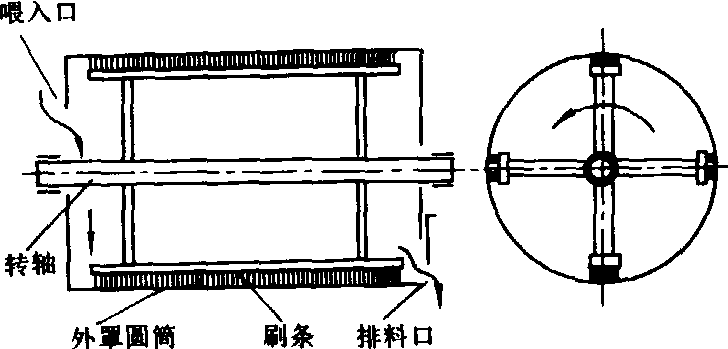蔬菜种子加工vegetable seed processing
对蔬菜种子采取清选、分级、干燥、消毒、脱毛或包衣等措施以提高播种品质量和保持种子较长寿命的过程。对茄果类蔬菜种子还包括采种后的去渣、脱胶和干燥等作业。
20世纪上、中叶随着城市规模的扩大,以及蔬菜种植面积的发展和集中,蔬菜种子加工逐渐受到重视,开始建立专业性的蔬菜种子公司和蔬菜种子加工厂。蔬菜种子加工是在大田作物种子加工技术的基础上发展起来的,因此基本工艺流程和机具配备类似,仅增加选配某些特殊要求的装置。此外,蔬菜品种繁多,对不同类品种的加工工艺略有差异。按大类划分有干加工工艺和湿加工工艺两种,前者直接加工十字花科、豆科以及干燥后的茄果类蔬菜种子;湿加工则是对茄果类蔬菜种子进行采子后的初加工。工艺流程的安排原则是:初清在前,精选在后;清选在前,分级在后;高生产率机具在前,排除杂质多的机具在后。典型的干加工工艺流程是: 进料→初清→除芒→刷光→风筛式基本清选→窝眼按长度选→重力(比重)分选→螺旋分选→拌药→包衣丸粒化→计量包装→入库贮藏与分发。
不同种子加工有不同流程,如十字花科种子不必除芒与刷光,对某些蔬菜种子还可附加磁选和电选等。各机具之间宜有必要的提升和输送装置,并考虑到流程和流向变换的可能性,还有集中除尘系统。为了保证工艺流畅,防止事故发生,宜有光电和音响报警系统和各机具间的停启连锁装置,主要操作都在统一的中央控制室内进行。在种子加工厂中还要设置质量检测室,随时对加工质量监控。
湿加工一般都把脱子和清除渣汁包含在流程内,其典型的工艺流程是: 喂料→破碎→分离(种子和种果的皮、汁、肉)→清洗去杂→酸处理去胶膜→漂洗去残酸和胶→甩去自由水→干燥。后续工艺与干加工相同。
蔬菜种子加工所用的许多机具与其他种子加工机具可以通用(见谷物种子加工),只是单个品种加工量少,常联系到产品中较小的型号。除此之外,由于不同品种间种子差别大(有的粒重相差达数千倍),要求在通用型机具上配备多种不同孔型和孔径的筛片以及不同穴眼的窝眼筒(盘),风量调节范围也应扩大。蔬菜种子加工时经常要用除芒机和刷式清理机清除番茄种子端部的茸毛、胡萝卜种子的芒毛,劈开干燥时被胶质粘附在一起的黄瓜种子等。有时还用抛光机增加种子的清洁度和光亮度,提高商品价值和便于利用。这三种机器在结构上都是一个内部安装有旋转工作部件的圆筒,其作用部件分别为打杆、翼板、条刷或其他相应刮扫件。工作时,种子从圆筒一端输入(见图),被条刷不断地带动旋转并搓刷,最终至另一端排出。有的筒身即为筛网,断碎的毛茸和刮下的尘土随时排漏出去。另一类在蔬菜种子加工中常用的是包衣机和制丸机(见甜菜种子加工),包衣机是利用混有农药化肥等的快干胶液(种衣剂),在种子外表裹一层薄膜,基本不改变种子的外形。制丸机则是利用各种药物、肥料、激素、吸水剂和增氧剂等,再加一定量的填充物,把种子裹成一定形状的外壳,以便增加细小种子的粒径、重量和尺寸均匀度;提高种子的流动性和着地时的稳定性;改善种子萌芽和苗期生长条件。制丸机有模压式、飘浮式和旋滚式等多种。旋滚式用得较多,其中的滚筒式有发展趋势,但更常见的还是旋锅式,它是一个轴心倾斜的旋转圆锅,种子在锅内跟着滚翻,分批依次向种子喷胶和撒粉,使种子外壳分层增大到所需粒径,最后加以烘干。电特性分选在蔬菜种子加工中颇受重视,电介电式分选机能提高发芽率7%~15%,增产15%~20%,还能使蔬菜收获期提前,品质改善。一些提高种子质量的物理、化学和生物措施在蔬菜种子加工中也时有应用,比如高低频电流处理、激光照射、各种生长激素的浸泡以及根瘤菌拌种等。

抛光机结构示意